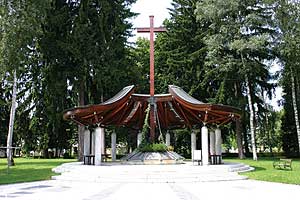Annabichl Cemetery
 The majority of those murdered in Klagenfurt/Celovec during national-socialism were buried in the Annabichl Cemetery, which was founded in 1902, in the Northern part of the city; mainly in areas I and IV which were paupers' graves at the time. The graves of approx. 1000 victims of national-socialism were in their majority abandoned, reallocated and relet - unlike the military personnel's graves. Up to now approx. 700 names of those buried here are known. They were mainly victims of euthanasia, forced labour or military jurisdiction; or they were resistance fighters murdered by the national-socialists.
The majority of those murdered in Klagenfurt/Celovec during national-socialism were buried in the Annabichl Cemetery, which was founded in 1902, in the Northern part of the city; mainly in areas I and IV which were paupers' graves at the time. The graves of approx. 1000 victims of national-socialism were in their majority abandoned, reallocated and relet - unlike the military personnel's graves. Up to now approx. 700 names of those buried here are known. They were mainly victims of euthanasia, forced labour or military jurisdiction; or they were resistance fighters murdered by the national-socialists.In the centre of the cemetery is a huge memorial site which was built in 1987. Underneath a pagoda-like wooden roof, there is a bronze plaque with all the names of the military personnel who are buried here. Among them German, Slavic, Italien and other names. There is no possibility to determine, who of them fought for or against national-socialism. The military cemetery stretches past this memorial site and leads to a further memorial: There is a red star on top of a large stone on which is written in Cyrillic writing: "Here lie the soldiers of the Soviet Army who died in action during the Fatherland War 1941-1945. Rest in peace." Further at the back, there is a small British Army cemetery.
Time and again deployments are staged at the large Annabichl Cemetery with its thousands of graves. Every year on 10 of October for example, on which "the fight for the German unity of Carinthia against the Slavic threat" during the Kärntner Abwehrkampf from 1918 to 1920 is commemorated. More space was demanded for these deployments in the course of a reorganisation of the memorial site - this space was made by covering up hundreds of graves with stone slabs. This way Carinthias notable politicians and Austrian Armed Forces celebrate the German nationalist victory over the "Slavic threat" on top of hundreds of Russians', Serbians', Slovenians' and Soviets' graves every year.